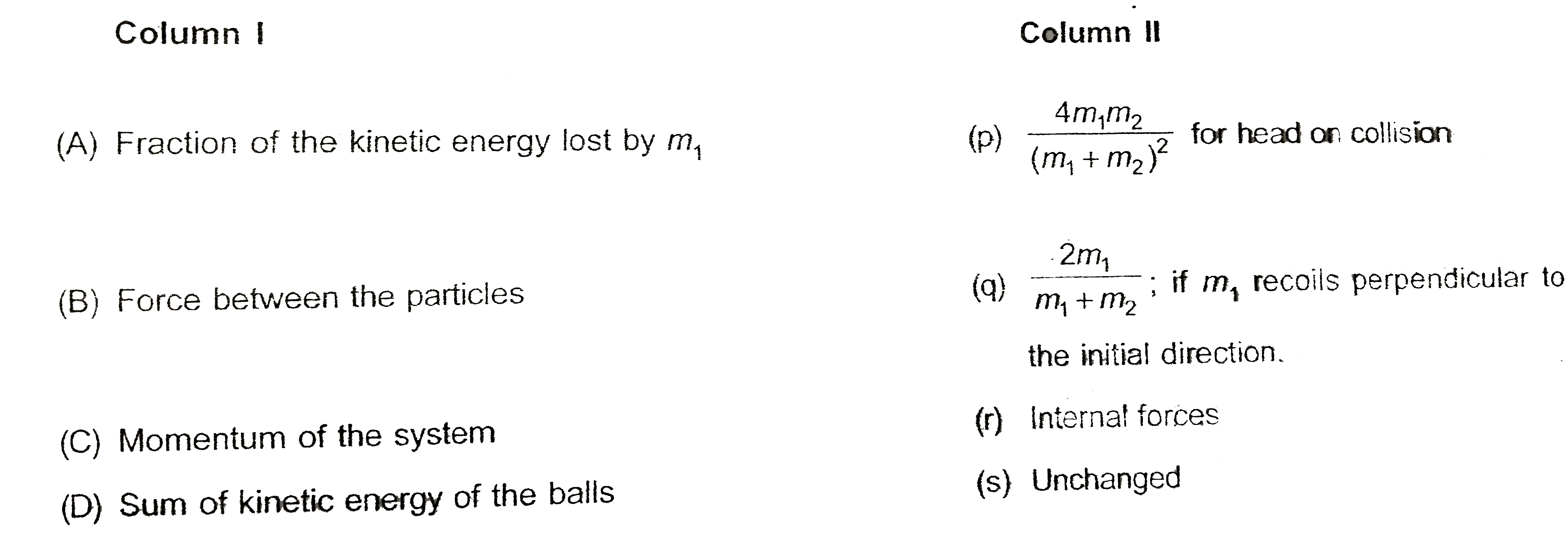A particle of mass m1 makes an elastic, one-dimensional collision with a stationary particle of mass m2.What fraction of the kinetic energy of m1 is carried away by m2?
m1m2
m2m1
2m1m2(m1+m2)2
4m1m2(m1+m2)2
The correct Answer is:D
Step by step video, text & image solution for A particle of mass m_(1) makes an elastic, one-dimensional collision with a stationary particle of mass m_(2).What fraction of the kinetic energy of m_(1) is carried away by m_(2)? by Physics experts to help you in doubts & scoring excellent marks in Class 12 exams.
Updated on:21/07/2023Topper's Solved these Questions
- KINEMATICS, FORCESBOOK - D MUKHERJEECHAPTER - KINEMATICS, FORCESEXERCISE - Type 2
22 Videos
- KINEMATICS, FORCESBOOK - D MUKHERJEECHAPTER - KINEMATICS, FORCESEXERCISE - Revision Exercise
26 Videos
- IIT QUESTIONS 5BOOK - D MUKHERJEECHAPTER - IIT QUESTIONS 5EXERCISE - Matrix matching type
2 Videos
- MISCELLANEOUS QUESTION 1BOOK - D MUKHERJEECHAPTER - MISCELLANEOUS QUESTION 1EXERCISE - Miscellaneous Questions-1 (Straight-Objective Type)
54 Videos
Similar Questions
A particle of mass m1 experienced a perfectly elastic collision with a stationary particle of mass m2. What fraction of the kinetic energy does the striking particle lose, if
(a) it recoils at right angles to its original motion direction,
(b) the collision is a head-on one?
View SolutionA particle of mass m experienced an elastic collision with a stationary particle of mass 2m . What fraction of the kinetic energy does the striking particle lose if recoils at the right angles to its original motion direction.
View Solution
Knowledge Check
A ball of mass m1 makes an elastic , one-dimensional collision with a stationary particle of mass m2. The fraction of the kinetic energy of m1 transferred to m2 is
A2m1m2(m1+m2)2B4m1m2(m1+m2)2Cm1m2(m1+m2)2D12m12m2(m1+m2)2A particle (A) of mass m1 elastically collides with another stationary particle (B) of mass m2. Then :
Am1m2=12 and the particles fly a part in the opposite direction with equal velocities.Bm1m2=13 and the particles fly apart in the opposite direction with equal velocities.Cm1m2=21 and the collision angle between the particles is 60∘ symmetrically.Dm1m2=21 and the particles fly apart symmetrically at an angle 90∘A particle moving with kinetic energy =3J makes an elastic head-on collision with a stationary particle which has twice its mass. During the impact :-
Athe minimum kinetic energy of the system is 1JBthe change in elastic potential energy of the system is 2JCmomentum and total energy are conserved at every instant.Dthe ratio of kinetic energy to potential energy of the system first decreases and then increases.
A particle of mass m1 experiences a perfectlly elastic collision with a stationary particle of mass m2. Match the entires in column I to all the entires in column II.

View SolutionA particle of mass m1, makes a head on elastic collision with another stationary body of mass m2 If m1, rebounds with half of its original speed then (m1m2) is
View SolutionA particle of mass m1 makes a head on elastic collision with another stationary body of mass m2, If m1 rebounds with half of its original speed then (m1m2) is
View SolutionA particle moving with kinetic energy=3 J makes an elastic head-on collision with a stationary particle which has twice its mass. During the impact:
View SolutionA particle of mass m1 makes a head - on elastic collision with another particle of mass m2 at rest. m1 rebounds straight back with 49 of its initial kinetic energy . Then m1m2 is :
View Solution
